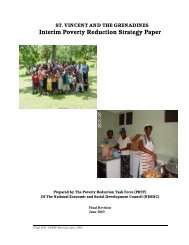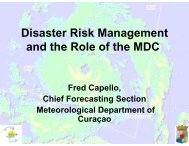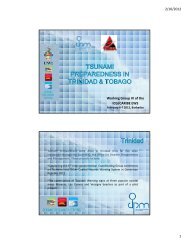The Anatomy of A Silent Crisis The Anatomy of A Silent Crisis
The Anatomy of A Silent Crisis The Anatomy of A Silent Crisis
The Anatomy of A Silent Crisis The Anatomy of A Silent Crisis
- TAGS
- anatomy
- www.bb.undp.org
You also want an ePaper? Increase the reach of your titles
YUMPU automatically turns print PDFs into web optimized ePapers that Google loves.
<strong>The</strong> human impact <strong>of</strong> climate change – Already serious today 15<br />
Vulnerability assessment<br />
More than one third <strong>of</strong> the world’s population are physically vulnerable to climate change 35<br />
Currently over 2.8 billion people live in areas <strong>of</strong> the world prone to more than one type <strong>of</strong><br />
the physical manifestations <strong>of</strong> climate change: floods, storms, droughts, sea level rise. Physical<br />
vulnerability to climate change is used to mean that an individual is vulnerable if they face a medium<br />
to high risk <strong>of</strong> experiencing at least two <strong>of</strong> these events. <strong>The</strong> figure below shows the areas which are<br />
most physically vulnerable to climate change. (In Section 3 below, please note that, when secondary<br />
socio-economic factors are included, over 4 billion people could be considered as vulnerable to<br />
climate change and, <strong>of</strong> these, over half a billion as extremely vulnerable.)<br />
Those most vulnerable live in the semi-arid dry land belt countries, sub-Saharan Africa, South and<br />
Southeast Asia, Latin America, Small island developing states and the Arctic<br />
People living in low-lying areas, the semi-arid dry land belt along the Sahel that separates<br />
Africa’s arid north from more fertile areas, easily flooded regions on the Equator, and glacier<br />
regions are most likely to be affected. <strong>The</strong> following countries and regions are considered the most<br />
vulnerable to climate change:<br />
• <strong>The</strong> semi-arid dry land belt countries because <strong>of</strong> overall vulnerability to droughts from the<br />
Sahara/Sahel to the Middle East and Central Asia. (<strong>The</strong> most affected countries include Niger,<br />
Sudan, Ethiopia, Somalia, Yemen, and Iran, all the way to Western/Northern China.)<br />
• Sub-Saharan Africa because <strong>of</strong> vulnerability to droughts and floods. (<strong>The</strong> most affected<br />
countries include Kenya, Uganda, Tanzania, Nigeria, Mozambique, and South Africa.)<br />
• South and Southeast Asia because <strong>of</strong> the melting Himalayan ice sheets, droughts, floods and<br />
storms. (<strong>The</strong> most affected countries include India, Pakistan, Bangladesh, southern and eastern<br />
China, Myanmar, Vietnam, Philippines and Indonesia.)<br />
• Latin America and parts <strong>of</strong> the US because <strong>of</strong> water shortages and floods. (<strong>The</strong> most affected<br />
countries include Mexico, Andean countries like Peru and Brazil.)<br />
• Small island developing states because <strong>of</strong> sea level rise and cyclones. (<strong>The</strong> most affected<br />
countries include the Comoros islands, Kiribati, Tuvalu, the Maldives and Haiti.)<br />
• <strong>The</strong> Arctic region because <strong>of</strong> the melting <strong>of</strong> ice caps.<br />
<strong>The</strong> region at most immediate risk <strong>of</strong> droughts and floods is sub-Saharan Africa. Droughts<br />
are most probable in Burkina Faso, Mozambique, Rwanda, Somalia and Tanzania, while Malawi,<br />
Mozambique, Nigeria, Somalia, Sudan and Tanzania are considered especially prone to floods.<br />
Flooding is also likely in South Asia (Afghanistan, Bangladesh and Nepal). <strong>The</strong> most storm-prone<br />
areas are along the coasts <strong>of</strong> East Africa (Mozambique, Madagascar) and South Asia (Bangladesh)<br />
as well as along the Southeastern and central areas <strong>of</strong> the US. 36,37







